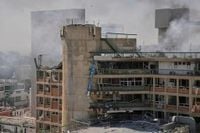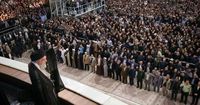As tensions escalate sharply between Israel and Iran, the international community watches with bated breath, wary of the profound regional and global implications. On June 20, 2025, the Kremlin delivered a stern warning against any attempts to force regime change in Iran, emphasizing that the assassination of Supreme Leader Ayatollah Ali Khamenei would "open Pandora's box" and provoke a "very negative" reaction from Russia. Kremlin spokesman Dmitry Peskov underscored the gravity of the situation in an exclusive interview with Sky News, cautioning that such actions would ignite extremist sentiments within Iran, potentially unleashing uncontrollable chaos.
Russia’s stance comes amid deepening ties with Iran, solidified by a strategic partnership signed earlier this year, reflecting Moscow’s vested interest in Tehran’s stability. Peskov described the current conflict as "extremely tense and dangerous not only for the region but globally," warning that expanding the number of participants would only escalate the conflict further. His comments mark the Kremlin’s strongest public position on the Israel-Iran confrontation, highlighting Moscow’s apprehension about losing its closest Middle Eastern ally amid the turmoil.
Meanwhile, the United States, under President Donald Trump, remains at a crossroads. Trump announced he would decide within two weeks whether America would join Israel’s military campaign against Tehran, after previously speculating on social media about the possibility of assassinating Khamenei. Trump’s administration has been actively engaged in the region, providing defensive support to Israel, including American pilots intercepting drones alongside Israeli forces, though the president insists that any U.S. involvement would not aim for a prolonged war but rather to ensure Iran never acquires a nuclear weapon.
Diplomatic efforts are also underway. On June 20, Iranian Foreign Minister Abbas Araghchi met with counterparts from the United Kingdom, France, and Germany in Geneva to discuss a diplomatic resolution to the conflict. This meeting marked the first major diplomatic exchange involving Iran since Israel’s recent strikes on Iranian nuclear facilities. While French Foreign Minister Jean-Noël Barrot emphasized the talks’ focus on achieving a lasting rollback of Iran’s nuclear and ballistic missile programs, Araghchi clarified that Iran’s missile program would not be part of the discussions, asserting, "Our missiles are for the defense of the country and to create deterrence." The meeting reflects a concerted European effort, alongside the U.S., to de-escalate tensions and curb Iran’s nuclear ambitions.
On the ground, hostilities continue unabated. Israel’s military reported striking dozens of military targets within Iran, including missile manufacturing sites and the headquarters of the SPND, the country’s main defense research organization. These strikes followed a barrage of Iranian missile attacks on Israeli territory, including a significant strike on the Soroka Medical Center in Be'er Sheva, causing extensive damage but fortunately resulting in no serious injuries. The conflict has already injured 65 people across Israel in recent missile barrages, underscoring the escalating human cost.
Israel’s Defense Minister Israel Katz warned Hezbollah’s leadership to avoid entanglement in the conflict, responding to threats from the Iran-backed Lebanese militant group. Katz accused Iran’s Supreme Leader of committing "the gravest of war crimes," condemning missile attacks targeting civilian infrastructure and hospitals. Hezbollah’s deputy leader, Naim Qassem, vowed full support for Iran, highlighting the proxy dynamics fueling the conflict and raising fears of a wider regional conflagration.
The question of regime change in Iran has become a focal point of debate. While Israeli Prime Minister Benjamin Netanyahu has not explicitly declared regime change as an objective, his rhetoric and the intensity of Israeli operations suggest it may be an implicit goal. Netanyahu has stated that Israel will strike "all" of Iran’s nuclear facilities and asserted capability to do so independently of U.S. assistance, although American support continues in defensive capacities.
Analysts remain divided on the feasibility and wisdom of pursuing regime change. Critics warn that such a strategy risks regional escalation, unintended political consequences, and empowering even more hardline elements within Iran’s leadership. They point to the fragility of Iran’s diverse ethnic and religious composition—Persians constitute only half of the population, with significant Azeri, Turkic, Baloch, Kurdish, and Arab minorities—raising concerns about potential Balkanization and chaos if the regime collapses without a clear plan for succession.
Supporters of a more aggressive stance argue that the Islamic Republic is weaker than ever, citing persistent public dissent, including the 2022 "Women, Life, Freedom" uprising that saw over 550 protesters killed and 20,000 arrested, and growing international isolation. They view this moment as a rare opportunity to facilitate the regime’s collapse, potentially paving the way for a democratic transition.
However, many observers agree that durable change in Iran must ultimately come from within. Military intervention alone, especially without significant groundwork to empower opposition movements, risks backfiring. Ilan Berman, senior vice president of the American Foreign Policy Council, emphasized the need for expanded communications and support to Iranian opposition groups to create the conditions for sustained internal resistance. Without these efforts, air strikes may strengthen hardliners and alienate ordinary Iranians.
Within Iran, potential scenarios for change range from internal coups led by junior military officers disillusioned with corruption and the war’s toll, to a popular revolution that might dismantle the unique religious governing structure. Rumors circulate about an emergency government involving former President Hassan Rouhani and former Foreign Minister Javad Zarif. The release of political prisoners like Mir Hossein Mousavi and Zahra Rahnavard could signal shifts in the political landscape. Meanwhile, Reza Pahlavi, the exiled son of Iran’s last monarch, has positioned himself as a figurehead for democratic transition, although his relevance and understanding of contemporary Iran remain contested.
Voices from within Iran express mixed sentiments. While many detest the regime, they also reject foreign intervention, fearing Tehran could become another Gaza—a city devastated by war. Nobel Peace Prize laureate Narges Mohammadi criticized calls for evacuation and violence, asserting that "democracy, human rights, and freedom cannot come through violence and war." The Coordinating Council of Iranian Teachers’ Trade Associations condemned warmongering policies, emphasizing that war is a calamity, not an opportunity.
As the conflict unfolds, the risks of broader escalation loom large. Kremlin spokesperson Peskov warned that an "enlargement" of the conflict is "potentially even more dangerous," underscoring the delicate balance at play. The international community remains engaged in a complex dance of diplomacy, deterrence, and defense, with the stakes higher than ever for regional stability and global security.
In this volatile environment, the future of Iran—and indeed the Middle East—hangs in the balance, shaped by the interplay of military actions, diplomatic negotiations, and the aspirations of millions yearning for peace and self-determination.


